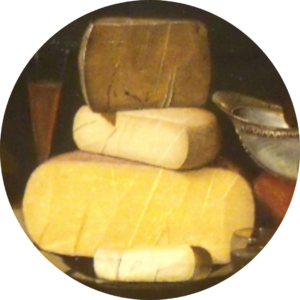When designing a cheese board to pair with Côtes du Rhône Villages wine, you’ll want cheeses that complement the wine’s profile. Côtes du Rhône Villages wines typically have bold, fruity, and spicy flavors with a mix of red and dark fruits, herbs, and earthy undertones, often with smooth tannins and balanced acidity.
To reduce the impact of tannins in red wine when pairing with cheese, the goal is to soften the wine’s astringency and create a smoother mouthfeel. Tannins, which come from grape skins, seeds, and oak barrels, can create a drying sensation in the mouth, so choosing the right cheese can help balance or counteract this effect.
Here are some tips for selecting a cheese to minimize the impact of tannins in red wine:
1. Opt for Creamy or High-Fat Cheeses
- Why it works: Fat helps to coat the palate and soften the drying effect of tannins, making the wine feel smoother and more balanced.
- Examples: Brie, Camembert, Triple Cream cheeses (like Brillat-Savarin), Saint-André.
- These rich, buttery cheeses have a smooth texture that mellows out the wine’s tannins.
2. Choose Aged Cheeses
- Why it works: Aged cheeses, such as mature cheddars or gouda, have a complex flavor and a firmer texture that stands up to the boldness of tannins, while their richness can still balance out the wine’s dryness.
- Examples: Aged Comté, Parmigiano-Reggiano, Aged Manchego, Pecorino.
- These cheeses offer nutty, savory flavors that complement the tannic structure without being overwhelmed.
3. Go for Blue Cheeses
- Why it works: Blue cheeses, particularly those with creamy textures, have strong, salty, and tangy flavors that counteract the bitterness of tannins. The saltiness in blue cheese helps enhance the fruitiness of the wine, and the creaminess tempers the tannins.
- Examples: Stilton, Gorgonzola, Roquefort, Fourme d’Ambert.
- Their intense flavors and creamy textures create a counterbalance to the wine’s dryness.
4. Look for Washed-Rind Cheeses
- Why it works: Washed-rind cheeses are rich and flavorful, with a strong aroma and creamy texture. These cheeses, like Taleggio or Epoisses, often have a savory, slightly funky profile that contrasts with tannins, making the wine taste less bitter.
- Examples: Epoisses, Taleggio, Reblochon, Munster.
- Their soft texture and bold flavors help smooth out the rough edges of a tannic wine.
5. Avoid Very Young, Fresh Cheeses
- Why to avoid: Fresh cheeses, like ricotta, mozzarella, or goat cheese, have high acidity, which can sometimes exacerbate the harshness of tannins, making the wine seem even more astringent.
- When they might work: Fresh cheeses can pair better with lighter, less tannic reds (e.g., Beaujolais or Pinot Noir), but are not ideal for very tannic wines like Cabernet Sauvignon or Syrah.
6. Consider Cheeses with Crystalline Textures
- Why it works: Cheeses with crystalline textures, such as aged gouda or Parmigiano-Reggiano, have a satisfying crunch and intense flavor that can complement and stand up to tannic wines. The sharp flavors of these cheeses help to balance the bitterness in the wine.
- Examples: Aged Gouda, Grana Padano, Parmigiano-Reggiano.
- These cheeses add complexity to the pairing and their sharpness can bring out the wine’s fruitier notes.
7. Salty Cheeses for a Contrast
- Why it works: Saltiness helps to reduce the perception of bitterness and tannins in wine, making the pairing more balanced. Salty cheeses also enhance the fruit flavors in red wine.
- Examples: Feta (aged), Roquefort, Pecorino.
- Salty cheeses work particularly well with fruit-forward red wines, as they enhance the natural sweetness in the wine.
8. Balance Intensity
- Why it works: Match the intensity of the cheese with the intensity of the wine. A very bold, tannic red wine will need a cheese with strong flavors and rich textures to avoid being overwhelmed.
- Examples: Strong-flavored cheeses like Stilton or aged cheddar can handle the intensity of wines like Cabernet Sauvignon or Syrah.
Key Guidelines
- Fat counteracts tannins: Rich, high-fat cheeses (especially creamy or triple cream varieties) soften the drying effect of tannins.
- Salt balances bitterness: Salty cheeses help reduce the perception of bitterness from tannins and enhance the wine’s fruitiness.
- Flavor intensity balance: Choose a cheese that matches the intensity of the wine so one doesn’t overpower the other.
- Avoid fresh cheeses with high acidity: For very tannic wines, avoid fresh cheeses as their acidity can clash with the tannins, making the wine taste harsher.
By choosing the right cheese, you can create a balanced and harmonious pairing that enhances the wine’s flavors and minimizes the impact of tannins.
Here are three Rhône cheeses and three additional non-Rhône cheeses to pair with this style of wine:
Rhône Cheeses
1. Picodon (Goat’s Milk)
- Origin: Drôme and Ardèche, Rhône region
- Texture: Semi-soft to firm, depending on age
- Flavors: Bright, citrusy, tangy, with earthy, grassy undertones
- Why It Works:
- Picodon has a slight tang and bright acidity that pairs beautifully with the fruity and herbal notes of Côtes du Rhône Villages.
- The mild earthiness of the cheese resonates with the wine’s subtle, rustic character.
- Tasting Notes: When young, it is fresh and lactic, with bright citrus flavors. As it ages, it becomes more intense and develops a nuttier, stronger flavor, with a creamier yet denser texture.
2. Saint-Marcellin (Cow’s Milk)
- Origin: Isère, Rhône-Alpes
- Texture: Soft, runny when ripe
- Flavors: Buttery, slightly tangy, nutty, and mushroomy
- Why It Works:
- Saint-Marcellin’s rich, buttery character and tangy finish complement the fruit-forward nature of the wine.
- The creamy texture balances the wine’s tannins, while the mushroomy, nutty flavors bring out the wine’s earthy and herbal qualities.
- Tasting Notes: A young Saint-Marcellin has a mild, milky flavor, while a mature one develops an intense, nutty, and earthy depth with a decadent, creamy texture.
3. Rigotte de Condrieu (Goat’s Milk)
- Origin: Condrieu, Rhône
- Texture: Soft, delicate, with a bloomy rind
- Flavors: Floral, herbal, mildly tangy
- Why It Works:
- The floral and herbal notes of Rigotte de Condrieu harmonize with the Rhône wine’s garrigue (herb) character.
- The light tang and creaminess cut through the wine’s fruitiness, adding contrast without overpowering the palate.
- Tasting Notes: This cheese offers subtle floral and herbal flavors with a gentle tang. Its soft, creamy texture softens the wine’s boldness, making for a well-rounded pairing.
Other Cheeses
1. Comté (Cow’s Milk)
- Origin: Jura, France
- Texture: Firm, smooth
- Flavors: Nutty, slightly sweet, with caramel and hazelnut undertones
- Why It Works:
- Comté’s nutty and sweet flavor profile contrasts and enhances the ripe fruit and spice of the wine.
- The cheese’s creamy, dense texture plays well with the smooth tannins of Côtes du Rhône Villages.
- Tasting Notes: Mature Comté has layers of flavor ranging from sweet and fruity to nutty and toasty, with a slightly crystalline texture that adds interest to each bite. It complements both the wine’s tannins and fruitiness.
2. Tomme de Savoie (Cow’s Milk)
- Origin: Savoie, France
- Texture: Semi-soft, pliable, with a natural rind
- Flavors: Mild, earthy, nutty, with grassy notes
- Why It Works:
- The mild, earthy flavors of Tomme de Savoie bring out the subtle earthiness and spice of the wine without overpowering its fruitiness.
- Its creamy texture complements the wine’s structure and acidity.
- Tasting Notes: Tomme de Savoie is slightly tangy with a milky freshness and rustic undertones. Its mildness makes it an excellent backdrop for the bold flavors of the wine, without clashing.
3. Reblochon (Cow’s Milk)
- Origin: Savoie, France
- Texture: Soft, creamy
- Flavors: Buttery, mildly fruity, with a hint of funk
- Why It Works:
- Reblochon’s buttery, fruity character complements the wine’s fruit-forward and slightly spicy profile.
- The cheese’s soft, rich texture helps soften the wine’s tannins, while its mild funk adds an intriguing complexity.
- Tasting Notes: Reblochon offers a smooth and buttery texture with a mild fruity flavor and a hint of pungency. The ripe, soft cheese melts in the mouth and coats the palate, enhancing the wine’s complexity.
Tasting Notes for Côtes du Rhône Villages and Bleu d’Auvergne Pairing
Côtes du Rhône Villages Wine:
- Appearance: Deep ruby red, often with purple highlights.
- Nose: Aromas of ripe red fruits (cherry, raspberry, plum) with hints of dark berries (blackberry, blackcurrant), often accompanied by spicy undertones of black pepper, licorice, and clove. Some herbal notes, like garrigue (wild thyme, rosemary), and earthy or smoky nuances may be present as well.
- Palate:
- Fruit: Juicy and full-bodied, with flavors of red and dark berries. The fruit-forward profile gives the wine a vibrant, fresh quality.
- Spice & Herbs: As the fruitiness evolves, more complex layers of spice (pepper, clove) and Mediterranean herbs (thyme, rosemary) emerge.
- Tannins & Acidity: Medium to high tannins give structure and grip to the wine, while a well-balanced acidity keeps it refreshing and lively.
- Finish: The finish is long and smooth, with lingering fruity, spicy, and slightly earthy notes.
Bleu d’Auvergne:
- Appearance: Creamy white with blue-green veining, crumbly yet moist texture.
- Aroma: Strong and pungent, with earthy, grassy, and mushroom-like aromas, along with a subtle hint of butter and cream.
- Flavor:
- Tang & Salt: The first impression is one of a tangy sharpness, balanced by a strong salty bite that is typical of blue cheeses.
- Earth & Grass: Behind the initial tang, deeper earthy, grassy flavors develop, sometimes with a hint of savory umami.
- Creaminess: Despite the bold flavors, there is a rich creaminess that coats the mouth, softening the intensity of the salt and tang.
- Finish: The finish is long and slightly peppery, with lingering earthy, mushroomy flavors.
Why This Pairing Works
- Fruit and Salt Contrast: The salty, tangy profile of Bleu d’Auvergne provides a bold contrast to the juicy, fruity flavors of the Côtes du Rhône Villages wine. The wine’s ripe red and dark berries temper the saltiness of the cheese, creating a balanced interplay.
- Spice and Earth Harmony: The earthy, grassy qualities of Bleu d’Auvergne resonate with the herbal, spicy notes in the wine. The wine’s peppery and herbal elements mirror the earthy depth of the cheese, creating a harmonious connection between the two.
- Creaminess and Tannins: The creamy texture of Bleu d’Auvergne helps to soften the tannic structure of the Côtes du Rhône Villages. The wine’s tannins, in turn, cut through the richness of the cheese, creating a smooth, balanced mouthfeel.
- Balanced Intensity: Both the wine and cheese have strong, layered flavors. The intensity of the cheese does not overwhelm the wine, and the wine’s complexity of fruit, spice, and earth matches the cheese’s boldness, making for a complementary pairing that enhances each element.
In this pairing, the Bleu d’Auvergne’s tangy, salty, and earthy notes are elevated by the fruitiness and spiciness of the Côtes du Rhône Villages, creating a dynamic and satisfying experience.
If you’re looking for a bolder combination, I suggest pairing Bleu d’Auvergne cheese with Cahors wine. The spicy notes, red fruit flavors, and peppery finish of the wine complement the cheese’s strong taste. The fruity and spicy notes in the wine balance out the cheese’s earthy and mushroom-like flavors. It’s a match made in heaven for those who enjoy bold and flavorful combinations.
Cheese Board Pairing Notes
- Texture balance: The creamy cheeses (Saint-Marcellin, Rigotte, Reblochon) contrast the wine’s bold tannins, while firmer cheeses (Comté, Tomme) offer a textural balance.
- Flavors: Each cheese offers flavors that harmonize with or complement the wine’s mix of fruit, spice, earth, and herbaceous notes, ensuring no single component overwhelms the pairing.
- Herbaceous Elements: Both Rigotte and Tomme de Savoie emphasize the herbal and earthy notes present in the wine, creating harmony.
By choosing a combination of these Rhône and non-Rhône cheeses, you’ll create a board that complements the full spectrum of Côtes du Rhône Villages’ flavors.
When pairing British cheeses with Côtes du Rhône wines, you’ll want to consider cheeses that complement the wine’s fruit-forward, spicy, and herbal notes. Here’s a selection of one blue, one soft, and one hard British cheese that work well with the bold profile of Côtes du Rhône, along with tasting notes and reasons for their pairing.
1. Blue Cheese: Stilton (Cow’s Milk)
- Origin: England (Derbyshire, Leicestershire, Nottinghamshire)
- Texture: Creamy yet crumbly, with blue veining
- Flavors: Rich, tangy, earthy, and salty, with a hint of sweetness
- Why It Works:
- Salt and Fruit Balance: The bold, salty tang of Stilton contrasts beautifully with the juicy red and dark fruits (cherry, blackberry, plum) in Côtes du Rhône. The wine’s ripe fruit softens the saltiness of the cheese.
- Earth and Spice Harmony: Stilton’s earthy and slightly savory flavors complement the herbal and spicy qualities of the wine, such as black pepper and thyme. The wine’s spices enhance the depth of the cheese, making it a well-rounded pairing.
- Tasting Notes: The first bite of Stilton delivers a pronounced tang with a creamy, crumbly texture. Its rich, salty flavor is balanced by a mild sweetness that pairs excellently with the wine’s fruitiness. The earthy, umami elements echo the wine’s herbaceous notes.
2. Soft Cheese: Tunworth (Cow’s Milk)
- Origin: Hampshire, England
- Texture: Soft, bloomy rind, creamy interior
- Flavors: Buttery, creamy, with mushroom and grassy notes
- Why It Works:
- Cream and Tannin Softening: Tunworth’s rich, creamy texture softens the tannins in Côtes du Rhône wines, creating a silky mouthfeel. The cheese coats the palate, helping to balance the wine’s structure.
- Earth and Fruit Contrast: The mushroomy and grassy flavors of Tunworth add an earthy dimension that contrasts with the wine’s fruity and spicy profile. The herbaceous undertones in the wine complement the subtle grassy notes in the cheese.
- Tasting Notes: Tunworth is indulgently creamy, with a delicate but intense flavor. As it ripens, the cheese develops deep, mushroomy and buttery notes that melt into the wine’s fruit-forward and spicy character, enhancing both the wine and the cheese.
3. Hard Cheese: Quicke’s Mature Cheddar (Cow’s Milk)
- Origin: Devon, England
- Texture: Firm, crumbly with some crystallization
- Flavors: Nutty, savory, slightly sweet, with a sharp tang
- Why It Works:
- Nutty and Fruity Complement: Quicke’s Mature Cheddar has a nutty, savory flavor that pairs well with the fruity elements of Côtes du Rhône. The sharpness of the cheddar cuts through the wine’s bold flavors while enhancing its fruity notes.
- Earth and Spice Balance: The cheddar’s depth and slight earthiness bring out the spicy, peppery aspects of the wine, creating a robust and balanced pairing.
- Tasting Notes: Quicke’s Cheddar is savory, with rich nutty flavors and a sharp finish. The crumbly texture and slight crystallization add a pleasant crunch. The cheddar’s mature complexity pairs harmoniously with the wine’s ripe fruit and peppery spice, enhancing the experience of both.
Why These Pairings Work with Côtes du Rhône Wines
- Fruit and Salt: Both Stilton and Quicke’s Cheddar have salty, tangy characteristics that contrast with the ripe fruit flavors of Côtes du Rhône, creating a harmonious sweet-salty balance.
- Earth and Herbs: The herbal, earthy notes in the wine find complementary flavors in the cheeses (especially Stilton’s earthiness and Tunworth’s grassy, mushroomy tones).
- Tannin and Creaminess: The creamy textures of both Stilton and Tunworth help to soften the wine’s tannins, while the firmer texture of Quicke’s Cheddar adds a satisfying textural contrast.
This selection of British cheeses offers a range of flavors and textures that balance and enhance the bold, spicy, and fruit-forward character of Côtes du Rhône wines.


